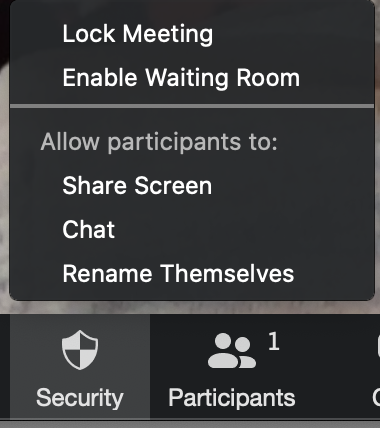Security Tips for Zoom Performances
 If you're looking to host a Zoom performance it's worth thinking through how (or if) you'd like your audience to engage with you.
If you're looking to host a Zoom performance it's worth thinking through how (or if) you'd like your audience to engage with you.
This guide will cover some of the critial features to consider for Zoom performances. If you would like more information or more tips on how to use and configure Zoom, check out HUIT's Zoom website.
Creating a Zoom Meeting
Here are some things to consider when creating your meeting at zoom.harvard.edu or on your Canvas site.
1. Set a password
 Harvard automatically adds a password to all of the meetings created within its Zoom ecosystem. You can either:
Harvard automatically adds a password to all of the meetings created within its Zoom ecosystem. You can either:
- use the default password that is provided to you (a random string of letters and numbers) and make sure that you give your participants the link that includes the password, or
- set a custom password and share the Zoom link with the custom password included or just the base link with a note about the password.
Either of these options work!
2. Set default options for participants
 You'll want to set the default video for host and participants to "off". Hosts and participants will still be able to turn on their video, but it won't be on automatically when they enter the room.
You'll want to set the default video for host and participants to "off". Hosts and participants will still be able to turn on their video, but it won't be on automatically when they enter the room.
 Under Meeting Options there are a few more things to consider.
Under Meeting Options there are a few more things to consider.
- Enable join before host Would you like folks to be able to join the meeting before you initiate it? If you're expecting a crowd, it may be best to make them wait until you are ready to start the stream. If that's the case, leave it unchecked.
- Mute participants upon entry You'll definitely want to check this one for a number of reasons: a. it's nice as a participant to be prompted to turn on your mic instead of entering a room with a live mic, and b. if you're wanting only folks who are invited to speak to have speaking priviledges, this will make it easier.
- Enable waiting room This option enables a waiting room where everyone who wants to view your performance have to wait before being admitted in by you or another host. There are some benefits, but you'll have to make sure that someone on your team has host priviledges and can monitor the waiting room for any stragglers or folks who left the call for any reason and want to reenter. If you are expecting a lot of people, having a waiting room might be too much work.
- Only authenticated users can join I don't recommend this option. You may lock out participants from the Harvard community who are choosing to access the Zoom call from their phones or another device where they aren't logged in to Canvas.
- Record the meeting automatically This is useful for saving your performance for posterity's sake. I'll update this section with a link to more tips on recording your session soon.
Running your Zoom Session
It's the big day!! When you enter your Zoom session, there are a few more options to consider before your audience arrives.
Security
 At the bottom of your screen, you can click Security that will bring up a few options. Here you can decide what permissions you will grant your participants.
At the bottom of your screen, you can click Security that will bring up a few options. Here you can decide what permissions you will grant your participants.
- Make sure that Share Screen is turned off.
- If you'd like participants to be able to access the Chat feature, leave it on. This can be a nice option for audience participation, especially if they are muted.
- The Rename Themselves permission can be useful, I'd recommend leaving it on for participants.
Participant options
 Click Participants in the bottom menu to open up the participants panel. As the host, you will have the options to Invite participants, Mute All, Unmute All, and more.
Click Participants in the bottom menu to open up the participants panel. As the host, you will have the options to Invite participants, Mute All, Unmute All, and more.
Muting Everyone If you want all participants to be muted, make sure that Mute Participants on Entry is selected and Allow Participants to Unmute Themselves is deselected.
Disable the chime To avoid distraction during your performance, make sure to deselect Play Enter/Exit Chime.
Make your collaborators Hosts
In the participant panel, you can make your collaborators hosts by clicking on their names, then clicking Make Co-Host.
